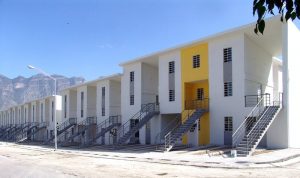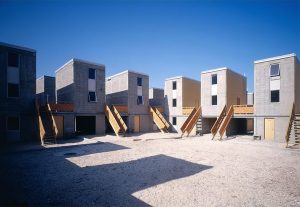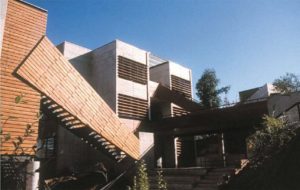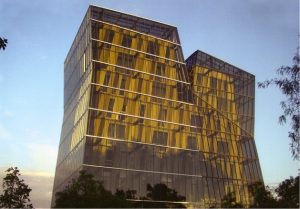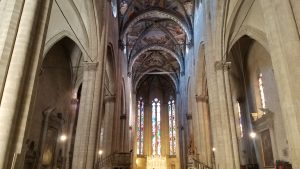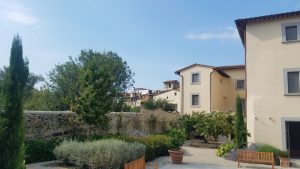Alejandro Aravena’s firm, Elemental S.A., has overseen the construction of a large amount of housing around Chile. The firm’s main concern seems to be to promote economic mobility in whatever ways they can by building this housing. This is expressed in two main ways by the firm. The first is building small, cheap housing that can be paid for with public funding (see above). The other, more interesting route, is the construction of “half of a good home,” by the firm, that the clients can afford with little cost, that also allows for space for the client to build onto the house later, once they are better able to finance a larger house (see below). Personally, I think these are great ideas, and examples of ways that architects and their firms can have a positive impact on the world in ways that aren’t strictly artistic. I hope that Oklahoma and other places around the world can learn from this strategy and model their own after it.
All posts by Jordan Perkins
Le Mans and Johnson Residential Halls of St. Edward’s University – Blog 7
The Le Mans and Johnson Residential Halls are… residential halls, designed and constructed by Alejandro Aravena. The buildings in many way continue the themes seen in other works by Aravena of modern architecture, with very airy construction, albeit in a controlled manner. From the outside, the buildings actually look very oppressive, with plain, polygonal concrete facades with the only features being rectangular windows that almost look like they’re crying because of the effect of rain on the façade. 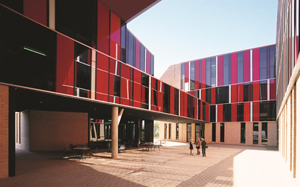
However, the interior area surrounded by the buildings, an open courtyard, is the polar opposite: displaying glass facades made up of a mixture of red, black, and white panels. The buildings also overhang much of the area surrounding the courtyard, only supported by thin columns, broadcasting a light appearance, in stark contrast to the exterior façade of the building. As far as I can tell, the dorms themselves are pretty standard for college dorms, but then again that’s what I thought about Couch Tower before I lived there.
Colegio Huelquen Montessori – Blog 6
The Colegio Huelquen Montessori is a school in Montessori, the main building of which was designed and constructed by Alejandro Aravena. I can’t find too many sources online about the school, past the school website run through Google Translate, my details of the school are iffy to say the least. As best as I can tell, it’s actually a school for children and adolescents. As for the building itself, it is quintessentially modern, with a combination of floating staircases, polygonal facings on the facades, and wide windows that give the building a very airy, open look. The materials for the exterior of the building appear to be concrete for structural components, faced with wooden paneling for aesthetic purposes. Personally, I wish more schools looked like this, not only just because I like the way it looks, but because the school avoids looking oppressive and closed off, as many schools in my experience tend to look. It’s surrounded by nature, and it is built to accentuate this, which I’d argue makes it more pleasant to go there.
Siamese Towers – Blog 5
The Siamese Towers are likely the most famous work of Alejandro Aravena, a Chilean architect who is the executive director of the Elemental S.A. firm and recipient of the Pritsker Architecture Prize in 2016, an award given to living architects for demonstrating “a combination of those qualities of talent, vision, and commitment, which has produced consistent and significant contributions to humanity and the built environment through the art of architecture.” The Siamese Towers are actually one structure, with the top split into two parts that lean away from each other, while sharing the same lower part, akin to Siamese twins. The Towers were built by Aravena and his team for the Pontifical Catholic University of Chile in Santiago (Aravena’s alma mater); more specifically, these towers were to hold the Center for Technological Innovation. Because of this, the university wanted the building to more or less scream innovation. The university specified that the building be built with a façade full of glass, to meet this need. Aravena and his team built the tower(s) in its unique shape to further enhance the high-tech look of it. The towers also have a double skin of glass, with a layer of air in between for thermal insulation. As the building is supposed to be used as a technology center, most of the interior rooms actually don’t face the exterior glass walls, in order to keep them dark.
Blog 4 – Arezzo Cathedral
The Arezzo Cathedral (more accurately called the Duomo, to differentiate it from the multiple other churches in Arezzo) is a medieval cathedral that I visited often while studying abroad in Arezzo. The cathedral is a mix of Gothic and Byzantine styles, with a nave that has the general layout of most gothic churches, minus a transept, and a Byzantine chapel connected to the side of the church. The chapel appears to be a later addition, as there are stained glass windows that can be seen from inside the nave, and that currently face directly into the structure of the chapel roof.
I visited the cathedral multiple times, initially just because I liked Gothic buildings, but later because I found it a good place to go to clear one’s head. It’s spacious, dark, quiet, and keeps people from interrupting you. Believe it or not, there were many times in my semester abroad where I was stressed out of my mind; going to the cathedral helped to ease that stress, and I wish there was such a place that was as easily accessed here in Norman.
Blog 3 – Rooney Family Center
The Rooney Family Center in Arezzo is where OU’s Study Abroad in Arezzo program is based out of. It is a refurbished, 12th century monastery, with literal layers of time within the building. I’ve been told that during renovations, they found remains of an older building that the current building was built over. Today, you can see an old, Roman-style column that was found, and a cistern. One could say that the purpose of the building has consistently been one form of education or another, transitioning from mostly religious education to that which is more consistent with a university setting with some opportunities for cultural enrichment.
The building was one of my favorite parts of studying abroad, as the layout to the building is very chaotic and organic, and there is plenty of natural lighting throughout the building. My favorite parts of the building included the tower, from which you could see much of the landscape surrounding Arezzo, and the Mensa, where I made many good memories either running events or just eating with friends.
Blog 2 – Bizzell Memorial Library
The Bizzell Memorial Library is a popular, well-advertised building on OU’s campus, visible through the whole South Oval and most elsewhere on campus where students take classes. The building is dedicated to OU’s fifth president, William Bennett Bizzell, and even has one of his desks in the Great Reading Room, arguably the most popular part of the building.
The building, especially the Great Reading Room, where I spend most of my time in the library, has allowed me to work and study in peace, greatly increasing my productivity while on campus. I choose this place to study and do my work, because it is (mostly) quiet and a place where you can be fairly certain that you’ll be left alone. It is also the most beautiful place that I’ve been to in Oklahoma, even if I’m biased towards the Gothic style.
Blog 1 – Notre Dame de Paris
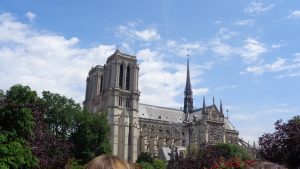
June 2018
No, don’t click away, I need this grade.
Notre Dame de Paris is a building that needs little introduction. It is a Gothic cathedral located at the center of Paris (physically and culturally, depending on the time period), that has seen its share of abuse and praise throughout the centuries. It’s original “meaning” or purpose was strictly the same of any other cathedral at the time: it was built as a place of worship, a symbol of the power of the Church and the French monarchy, and a center for education, as education in medieval times was centered around the church, rather than specialized campuses. Since then, it has become a cultural icon in Western Europe, symbolizing to many the virtues of tradition and maintaining a cultural history.
Notre Dame has been in the public eye since its construction, and especially since Victor Hugo’s novel of the same name was released, but more recently, since the fire that burned the majority of the roof, toppled the spire, and poked many a hole into the ceiling, it seems that everyone has an opinion on the building, whether positive or negative, and that everyone has voiced said opinion.
So, why write about it? First of all, because I want to. Second, because I think I have a moderating opinion on the building that’s supported with knowledge of the context of the history of the building and of Gothic architecture in general.
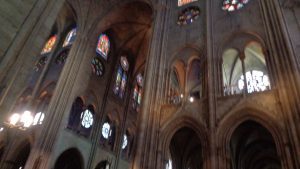
So, a bit of personal context: I visited Notre Dame de Paris as part of a 17 day trip around Western Europe in June 2018. This was my first time visiting any foreign country, and it’s when I was introduced to Gothic architecture. The first Gothic building I visited was Westminster Abbey, but for whatever reason (maybe actually being allowed to take pictures), Notre Dame was the one that stuck with me. It could also be that I got some time to just sit down and take a good look, rather than rushing around trying to see everything. One of my friends wanted to pray, so I went with him to one of the pews and sat down. Cameras weren’t allowed in the pews, and I’m not much of the praying type, so I just took a long look at the vaulted ceiling and the stained glass forming a stone cocoon around us. I knew very little of the history of the building, or of the mechanics of how its support structures work, so all I could recognize at the time was that it was a very pretty building.
Since then, I’ve learned a thing or two about Gothic architecture and about the history of Notre Dame in particular, and, as is usually the case when I’ve researched a topic well-enough, I take the kind of moderate perspective that pisses off both sides of the fence.
Let me be clear: I don’t think Notre Dame de Paris, the building, is more important than any one life, or that it is more important, in any objective way, than any other cultural icon from around the world. Even in French history, I’d point to Saint Denis as an equal to Notre Dame in significance. I also don’t pretend to believe that the French billionaires that promised to donate millions of Euros to help rebuild the cathedral did so out of the goodness of their hearts, instead of out of trying to boast about their money. However, I also don’t think that the irritation people express towards Notre Dame is justified. I think that the rebuilding of Notre Dame does not in any way take away from whatever cause people want to support. In fact, I’d argue that rebuilding it helps to keep the tourism that drives the Parisian economy coming, and that not rebuilding it would be a greater waste in the long run.
As for the rebuilding, I hope that people don’t forget that the process of rebuilding hasn’t even begun. Notre Dame is still being reinforced, and the melted support structures around the crossing still have to be removed (risking further damage to the building) before architects can even begin to think about rebuilding Notre Dame. However, I do think that Notre Dame will be rebuilt and that once it is, the fire will just be another part of its history, just like the desecration of the building during the French Revolution.
